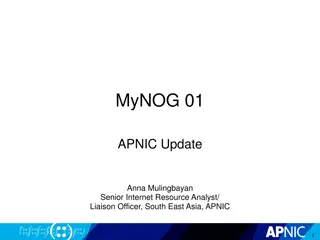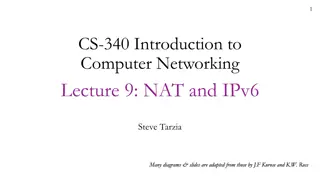Challenges and Wins in Anonymizing IPv6 PCAPs
Sanitizing PCAPs is crucial to protect sensitive data such as user credentials, network topology, and vulnerable protocols. This article discusses the importance of PCAP sanitization, tools available for the task, general challenges faced, and goals to achieve in the process.
Download Presentation

Please find below an Image/Link to download the presentation.
The content on the website is provided AS IS for your information and personal use only. It may not be sold, licensed, or shared on other websites without obtaining consent from the author.If you encounter any issues during the download, it is possible that the publisher has removed the file from their server.
You are allowed to download the files provided on this website for personal or commercial use, subject to the condition that they are used lawfully. All files are the property of their respective owners.
The content on the website is provided AS IS for your information and personal use only. It may not be sold, licensed, or shared on other websites without obtaining consent from the author.
E N D
Presentation Transcript
Machine learning in cybersecurity ROMAN ODARCHENKO, DSc, professor Chair of Telecommunication and radio engineering systems academic department National aviation university, Kyiv, Ukraine Senior researcher, State Research Institute of Cybersecurity Technologies CEO of the Scientific Cybersecurity Association of Ukraine International school Cyber Security and AI | October 26-27, 2023| Tbilisi
Questions for the discussion What are the most spread applications of AI and ML? What are the best machine learning tools products? Can you tell examples of AI applications in FB, Netflix?
Examples of AI applications in FB, Netflix Example 1: If you have used Netflix, then you must know that it recommends you some movies or shows for watching based on what you have watched earlier. Machine Learning is used for this recommendation and to select the data which matches your choice. It uses the earlier data. Example 2: When you upload a photo on Facebook, it can recognize a person in that photo and suggest you, mutual friends. ML is used for these predictions. It uses data like your friend-list, photos available etc. and it makes predictions based on that.
10+ Most Popular Machine Learning Software Tools (1) Tool Algorithms or Features Platform Cost Written in language Scikit Learn Linux, Mac OS, Windows Free. Python, Cython, C, C++ Classification Regression Clustering Preprocessing Model Selection Dimensionality reduction. Autograd Module Optim Module nn Module Provides a library for dataflow programming. PyTorch Linux, Mac OS, Windows Free Python, C++, CUDA TensorFlow Linux, Mac OS, Windows Free Python, C++, CUDA Weka Linux, Mac OS, Windows Free Java Data preparation Classification Regression Clustering Visualization Association rules mining Can work with large data volume. Supports text mining & image mining through plugins KNIME Linux, Mac OS, Windows Free Java
10+ Most Popular Machine Learning Software Tools (2) Tool Platform Cost Algorithms or Features Written in language Colab Cloud Service Free - Supports libraries of PyTorch, Keras, TensorFlow, and OpenCV Preprocessors Regression Clustering Recommenders Distributed Linear Algebra. Classification Regression Distribution Clustering Hypothesis Tests & Kernel Methods Image, Audio & Signal. & Vision Apache Mahout Cross-platform Free Java Scala Accors.Net Cross-platform Free C# Shogun Windows Linux UNIX Mac OS Free C++ Regression Classification Clustering Support vector machines. Dimensionality reduction Online learning etc. API for neural networks Data loading & Transformation Data preprocessing & visualization. Keras.io Rapid Miner Cross-platform Cross-platform Free Free plan Small: $2500 per year. Medium: $5000 per year. Large: $10000 per year. Python Java
The best AI photo editors Adobe Photoshop for a full-featured photo editing and design app Luminar Neo for an AI-powered photo editor Canva for an AI-powered design app Pixlr for an easy-to-use online AI editor Lensa for a mobile AI photo editor
11 Best AI Image Generators in 2023 Visme DALL-E Craiyon Midjourney Jasper Art NightCafe Deep AI Runway AI Bing Image Creator DreamStudio by Stability AI Wombo Dream
11 Best AI Image Generators in 2023 Play.ht Murf.AI Listnr Speechify LOVO (Genny) Synthesys Resemble.AI Clipchamp
The best AI video generators Descript for editing video by editing the script Wondershare Filmora for polishing video with AI tools Runway for experimenting with generative AI Peech for content marketing teams Synthesia for using digital avatars Fliki for social media videos Visla for turning a script into a video Opus Clip for repurposing long-form to short-form video
Best AI Tools for Writing and Content Creation ClickUp ChatGPT Jasper GrammarlyGO Copy.ai Wordtune Writesonic Rytr GitHub Copilot TabNine
Best AI Tools for Meetings Spinach Sembly Fireflies Krisp Otter.ai
List of TOP Artificial Intelligence Tools ChatGPT Google Bard Chatsonic Midjourney DALL-E SlidesAI Alli AI Jasper AI Paradox Synthesia aiXcoder TabNine DeepBrain AI
Malware Detection Malware is a significant danger to cybersecurity. It has the capability of stealing data, causing system damage, and disrupting corporate operations. Traditional anti-virus software detects malware using signature-based detection. This strategy, however, is no longer effective against contemporary malware, which is engineered to avoid detection. Machine learning algorithms can be trained to detect malware based on its behavior rather than its signatures. Machine learning algorithms can uncover patterns consistent with infection by analyzing the behavior of files and processes. This method detects new and undiscovered malware more effectively and can assist organizations in staying ahead of cyber threats.
The list of the best malware detection tools and analysis software: SolarWinds Security Event Manager EDITOR S CHOICE The best defense for businesses looking for a robust system that can handle a large number of devices and the log data that comes from them. Start 30-day free trial. ManageEngine Log360 (FREE TRIAL) This large package provides security for on-premises systems and cloud services with integrated user monitoring and data loss prevention. Start a 30-day free trial. ESET Protect (FREE TRIAL) An anti-virus endpoint protection package that can be extended by cloud-based centralized threat hunting. Runs on Windows, macOS, Linux, iOS, and Android. Start a 30-day free trial. LogRhythm NextGen SIEM Platform Complete defense system that takes care of threats from start to finish in a single, unified architecture. Splunk Enterprise Security SIEM tool that keeps up with the sophistication of the complex threats of today and has advanced security monitoring and threat detection capabilities. CrowdStrike Falcon An endpoint protection platform that uses AI processes to detect malware activity. This innovative cybersecurity tool combines the use of onsite data collection agents with a cloud-based analysis engine. CyberRes ArcSight ESM Real-time correlation of log data, at the rate of 100,000 events per second makes this the fastest SIEM solution available for enterprises.
Anomaly Detection The practice of finding occurrences or patterns that differ from the usual is known as anomaly detection. Anomaly detection in cybersecurity can be used to spot strange behavior that may suggest a cyber assault. Anomalies in network traffic, user behavior, and system activity can be identified using machine learning methods. Machine learning algorithms can spot patterns consistent with cyberattacks, such as unauthorized access attempts or anomalous data transfers, by analyzing massive volumes of data.
Anomaly Detection tools Splunk User Behavior Analytics Weka Coralogix Loom Systems Anodot Avora DataRPM
Fraud Detection Many organizations, particularly those in the financial industry, are concerned about fraud. Credit card fraud and identity theft, for example, can result in considerable financial losses and harm to an organization's brand. Machine learning systems can detect fraudulent actions by analyzing data trends. Machine learning algorithms, for example, may analyze credit card transactions to find patterns indicative of fraud, such as a rapid spike in purchases or transactions from unexpected places. Organizations may reduce losses and safeguard their consumers by discovering fraud early.
Threat Intelligence Threat intelligence is gathering and analyzing data in order to identify possible cyber threats. Machine learning algorithms may be used to identify possible dangers by analyzing enormous volumes of data from numerous sources, such as social media, dark web forums, and security blogs. Machine learning algorithms can find trends in this data that may suggest a future cyber assault. This data may be utilized to strengthen an organization's cybersecurity posture by detecting vulnerabilities and putting in place suitable security measures.
User Authentication The process of authenticating a person's identification is known as user authentication. Unauthorized access to systems and data can cause severe damage, therefore this is a key component of cybersecurity. By analyzing user behavior and recognizing patterns that are compatible with authorized access, machine learning algorithms may be used to improve user authentication. Machine learning algorithms, for example, may analyze keystrokes and mouse movements to identify each user's distinct behavior. This data may be used to build a behavioral profile of each user, which can then be used to validate their identity.
Conclusion In conclusion, machine learning is an effective tool that may assist organizations in improving their cybersecurity posture. Machine learning algorithms may assist organizations in staying ahead of cyber risks by analyzing massive volumes of data and discovering trends that may suggest a prospective cyber assault. Machine learning has numerous and diverse uses in cybersecurity, ranging from virus detection to user authentication. As cyber threats change, organizations must adopt machine learning as a critical component of their cybersecurity strategy.
Potential usage of GPT for cybersecurity needs Anomaly Detection: GPT can be trained on network logs and other security data. The model can then be used to detect anomalies in network traffic or user behavior. Attack Signature Generation: GPT can generate signatures for known attacks based on the analysis of textual descriptions of attacks. These signatures can be used in intrusion detection systems. Textual Information Analysis: GPT can be used to analyze threats from textual sources such as news articles, blogs, and forums. The model can help identify new cybersecurity threats and trends. Automatic Incident Response: GPT can be integrated into incident response systems for automatic incident analysis and classification, as well as providing response recommendations. Filtering Malicious Websites and Emails: GPT can be used to analyze the content of websites and emails to detect potentially malicious content. Security Recommendations Generation: GPT can generate security recommendations based on the analysis of specific situations and vulnerabilities.
Step-by-step approach to perform attack signature generation using GPT: Data Collection and Labeling: Gather a dataset of textual descriptions or reports of known cyberattacks. These descriptions should include information about the attack techniques, tactics, procedures, and other relevant details. Data Preprocessing: Preprocess the textual data to clean it and make it suitable for training a language model like GPT. This might involve tokenization, removing special characters, and formatting the text. Model Selection: Choose a pre-trained GPT model (e.g., GPT-3 or GPT-4) to use as the foundation for generating attack signatures. You can fine-tune this model for your specific attack signature generation task. Fine-Tuning: Train the selected GPT model on the labeled dataset. During fine-tuning, the model learns to generate text that describes attack signatures based on the patterns it observes in the training data. You'll need to set up a language modeling objective that encourages the model to generate coherent and informative attack signatures. Signature Generation: Once the model is fine-tuned, you can use it to generate attack signatures. Provide a seed phrase or context that specifies the type of attack you want to generate a signature for, and the model will generate a signature based on the patterns it has learned. Review and Validation: Review the generated attack signatures to ensure they are accurate and relevant. It's essential to validate the generated signatures to make sure they reflect the actual attack techniques and can be used for detection. Integration: Integrate the generated attack signatures into your intrusion detection or prevention system (IDS/IPS) or security tools that use signatures for threat detection. Testing: Test the effectiveness of the generated signatures by simulating attacks or using historical attack data. Ensure that the signatures effectively identify the corresponding attacks. Maintenance: Regularly update and maintain the attack signatures. As new attack techniques emerge, you may need to retrain or fine-tune the GPT model and generate new signatures. It's important to note that attack signature generation with GPT is based on textual descriptions of attacks. While GPT can generate descriptive text, the quality and accuracy of the generated signatures will depend on the quality of the training data and the ability of the model to generalize from that data. Additionally, the generated signatures should be just one part of a comprehensive security strategy that includes other detection methods and layers of defense.
Additional materials Global Artificial Intelligence (AI) in Cybersecurity Market Insights and Forecast to 2028: https://www.extrapolate.com/information- technology-communication-iot/artificial-intelligence-ai-in- cybersecurity-market-report/70440?utm_source=8050
















![National WinS Data Collection and Analysis in [Insert Country]](/thumb/234463/national-wins-data-collection-and-analysis-in-insert-country.jpg)






